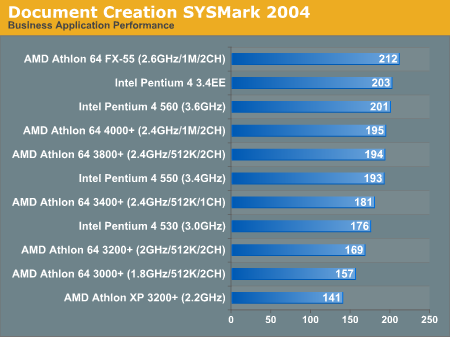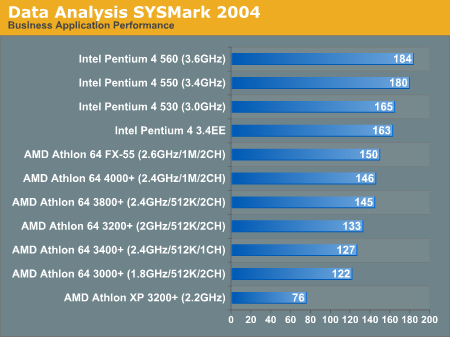AMD Athlon 64 4000+ & FX-55: A Thorough Investigation
by Anand Lal Shimpi on October 19, 2004 1:04 AM EST- Posted in
- CPUs
Business/General Use Performance
Business Winstone 2004
Business Winstone 2004 tests the following applications in various usage scenarios:
. Microsoft Access 2002
. Microsoft Excel 2002
. Microsoft FrontPage 2002
. Microsoft Outlook 2002
. Microsoft PowerPoint 2002
. Microsoft Project 2002
. Microsoft Word 2002
. Norton AntiVirus Professional Edition 2003
. WinZip 8.1
AMD has always dominated performance under business applications, which is why in the past they have always been known as a good CPU maker for office applications. Obviously with the K7 and K8 series of processors AMD changed the rules of the game a bit, offering top of the line performance in far more than just office applications. However, despite AMD's improvements in performance elsewhere, the Athlon 64 continues to hold on as the fastest processor for business applications.
Here we see that there is no performance difference between the three 2.4GHz parts, which is to be expected considering the relatively small datasets and correspondingly low bandwidth nature of business applications.
Even the entry level Athlon 64 3200+ is able to outperform Intel's top of the line Pentium 4 560 here. While Intel will argue that performance here doesn't matter, what does matter is that AMD is faster at a lower price point. Even the old Athlon XP 3200+ is able to offer performance similar to the Pentium 4 550.

Office Productivity SYSMark 2004
SYSMark's Office Productivity suite consists of three tests, the first of which is the Communication test. The Communication test consists of the following:
"The user receives an email in Outlook 2002 that contains a collection of documents in a zip file. The user reviews his email and updates his calendar while VirusScan 7.0 scans the system. The corporate web site is viewed in Internet Explorer 6.0. Finally, Internet Explorer is used to look at samples of the web pages and documents created during the scenario."
While the Athlon 64 FX-55 and 4000+ manage to land on top, it isn't by a huge margin. The FX-55 holds just under an 8% performance advantage over Intels Pentium 4 3.4EE. The Pentium 4 550 and Athlon 64 3800+ tie in the middle, while the 3400+ offers statistically similar performance.
What's interesting to note here is that the Athlon XP 3200+ manages to outperform, ever so slightly, the newer Athlon 64 3000+, thanks to a somewhat shorter pipeline and higher clock speed. What these results tell us is that the Communication test is much less dependent on the memory subsystem, rendering the on-die memory controller advantages of the Athlon 64 relatively useless. Our theories are confirmed by the fact that there's virtually no difference in performance in the single and dual channel memory configurations of the Athlon 64. There is, however, a boost in performance when going from a 512KB cache to a 1MB cache (3800+ -> 4000+), indicating that the datasets here are too big for a 512KB cache, but fit much better in a 1MB cache.
The Pentium 4 does relatively well here, with the Prescott based 90nm 560 offering similar performance to the Northwood based 130nm 3.4EE, with the higher clock speed able to make up for Prescott's other shortcomings.

The next test is Document Creation performance, which shows very little difference in drive performance between the contenders:
"The user edits the document using Word 2002. He transcribes an audio file into a document using Dragon NaturallySpeaking 6. Once the document has all the necessary pieces in place, the user changes it into a portable format for easy and secure distribution using Acrobat 5.0.5. The user creates a marketing presentation in PowerPoint 2002 and adds elements to a slide show template."
The inclusion of a speech recognition test as a part of this next benchmark immediately excludes the older generation of processors from being in the running for top performance spots. The lack of an on-die memory controller keeps the Athlon XP 3200+ at the end of the pack, while the more bandwidth friendly Pentium 4 and Athlon 64 platforms battle it out for the lead here.
The Athlon 64 FX-55 manages to secure a small 5% lead over the 3.4EE and the Pentium 4 560. It's not a noticeable performance lead in the real world, but it does stand on paper (or on web if you prefer). We once again see that there's no huge benefit to the 4000+'s 1MB L2 cache, but the dual channel configuration of our Socket-939 platforms clearly comes in handy, resulting in a 7% performance boost for the 3800+ over the single channel 3400+.

The final test in our Office Productivity suite is Data Analysis, which BAPCo describes as:
"The user opens a database using Access 2002 and runs some queries. A collection of documents are archived using WinZip 8.1. The queries' results are imported into a spreadsheet using Excel 2002 and are used to generate graphical charts."
Although not quite the enterprise level server database, MS Access does get used quite frequently in small to medium sized business environments to handle light database loads.
Here the Pentium 4s completely dominate, with the Prescott core truly extending the performance lead here. None of the AMD chips even stand a chance, not to mention the thrashing that the XP 3200+ gets. The Data Analysis tests do prove that despite the performance in other areas, there are a few pedestals that the Pentium 4 does continue to stand quite high upon.











89 Comments
View All Comments
val - Wednesday, October 20, 2004 - link
for me is AMD unacceptable until there are good chipsets. All i have ever seen or had in my computers was big garbage with permanent problems and mysterious difficulties.Even SIS chipsets looks much better for intel than SIS for AMD. Its not anymore about CPU, CPU are fast for many tasks and that few percent of price or performance makes no deal, but overall quality talks strongly for Intel.
Save your time AMD fanboys to reply me something like that your AMD platform runs perfect and you had problems with intel and so on, its cheap and cannot anyway motivate me for change.
And yes, i have 2 AMD and 2 Intel computers and many i had or seen before (at home, work, school, projects, customers).
Gnoad - Wednesday, October 20, 2004 - link
3GHZ! Wow, I already was an AMD fan, but that just totally blows me away. Crazy stuff.GoHAnSoN - Tuesday, October 19, 2004 - link
nice article. Thxcoldpower27 - Tuesday, October 19, 2004 - link
Very nice, I await the day AMD releases a 3GHZ Athlon 64. These processor are niced but priced in a range where volumes are rather low, they have nice bragging rights though :PDa DvD - Tuesday, October 19, 2004 - link
3GHz on air :SAMD's really out of trouble for the coming year(s)
I can imagine K8@90nm scaling well beyond 3GHz...
(lol, or even top Prescott clockspeeds? That would be insane..)
Wesley Fink - Tuesday, October 19, 2004 - link
#30 and #43 -Once AMD informed us that strained silicon was used in the FX55 I couldn't resist a bit of a run with overclocking the FX55. The nForce4 Reference boad is not really intended or designed for overclocking, since it doesn't have any CPU or memory voltage adjustments. However it does support a wide range of multipliers so I could try a few settinngs.
I had no probelm at all running at 14.5X or 2.9GHz at default voltage. At that speed I ran quite a few benchmarks and a Quake 3 of 604.2 FPS. The FX55 actually booted at 3.0GHz but it never made it through a stable XP boot. I suspect with just a bit of CPU voltage 3.0GHz would be possible with the FX55 on air. All cooling was just the new AMD stock fan which now includes copper fins and heat pipes.
verybusy - Tuesday, October 19, 2004 - link
There is some FX55 and 4000+ overclocking info at http://www.hothardware.com/viewarticle.cfm?page=2&...Assuming that my request from above is granted regarding other overclocking of 3500+, 3200+ and 3000+, I'd like to see just how overclocking turns out with the retail heatsink and fan. I hope that's not too much of a request.
Thanks...
verybusy - Tuesday, October 19, 2004 - link
I liked the review of the Athlon 64 4000+ and FX-55 and it was nice to see it compared to the other Athlon 64 3200+ and 3000+ processors running at stock speeds.Unfortulately, with this review following so closely behind the 3500+ and 3000+ review (.09 Athlon 64: Value, Speed and Overclocking), it would have been very useful to see the 3500+, 3200+ and 3000+ overclocked to 2.6GHz as well. Afterall, the .09 3500+/3000+ @290x9 is faster than the FX53 (2.4GHz-1MB) err I mean Athlon 64 4000+). The overclocked 3500+, 3200+ and 3000+ could be pretty much as quick as the FX55 couldn't it?
That's what I want to see anyway.
ViRGE - Tuesday, October 19, 2004 - link
#39, Anand mentions that it's multiplier locked.Zebo - Tuesday, October 19, 2004 - link
Guys the 3400 newcastle is a way underated chip. It should have been, by all rights, called a 3600. I guess they did'nt want the 3500 to look bad agains a "old" 754 newcastle though.As for the review, total AMD performance domination at low relative speeds temps and power consumption.:) Youd have to be a fool to buy intels netburst crap right now.